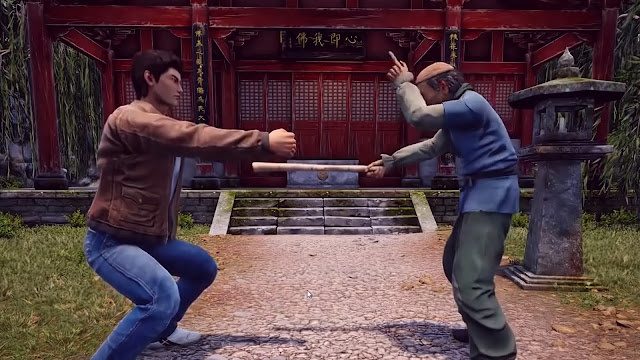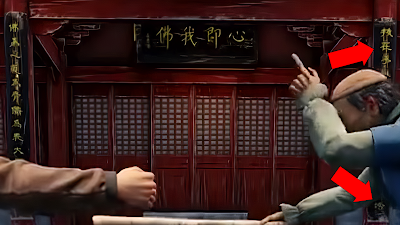Today's post is a guest post contributed by Shenmue Dojo’s yuc02 and Araviel (Chao Yu and Hanna). Read on as they explain the meaning of the Chinese writing that can be seen decorating a building in the recent "Ryo and Master" trailer.
Note: upscaling & noise reduction has been applied to some of the images, to aid readability.
As this blog continues to showcase, the recent “Ryo and Master” MAGIC 2019 trailer has given us a bunch of fascinating aspects to explore and discuss!
In one of the segments with the old, drunken Master himself, Ryo is training outside in front of the entrance to a traditional Chinese building. Above the door frame we can see horizontally-written characters on a sign as well as writing running vertically down the central pillars. These form a very commonly-used decoration for traditional Chinese buildings.
 |
| Writing can be seen above the entrance and on the front pillars. |
The building’s placard says 心即我佛, meaning:
"The mind is Buddha" (ref. "and my mind is the Buddha mind").
 |
| The building's placard says 心即我佛 (the characters are written from right to left). |
The writing down the left-hand pillar says 佛为心,道为骨,儒为表,大度看世界, meaning:
"Let Buddha be your heart, (Dao) principles be your bones, (calm) Confucianism be your appearance, view the world with an open mind".
 |
| The writing on the left-hand pillar. |
After further discussing between ourselves and digging online, we discovered that the couplet isn't random either. It seems to have actually originated from a poem by a Chinese Confucianism scholar in the early 20th Century, named Nan Huaijin (南怀瑾). Master Nan was trained in all the three Chinese major schools of thought; Buddhism, Confucianism and Daoism. We believe he must have read Master Mazu's teachings. Perhaps that inspired this poem?
The full poem reads like this:
南怀瑾参悟人生
佛为心,道为骨,儒为表,大度看世界;
技在手,能在身,思在脑,从容过生活。
三千年读史,不外功名利禄;
九万里悟道,终归诗酒田园。
Translated to English, the poem goes:
Nan Huaijin Life's Ponderings
Let Buddha be your heart, (Dao) principles be your bones, (calm) Confucianism be your appearance, view the world with an open mind;
Have skills in your hands, ability in your body, contemplation in your mind, live a simple life.
Three thousand years of teachings, don't seek fame or wealth;
Ninety thousand miles of revelations, finally return to poetry and wine in the farm fields.
Yu Suzuki decided to include the first part of the poem and we expect the right-hand pillar to complete the couplet.
Perhaps he wanted to show players his perspectives on how to live life, not to pursue short term gains or superficial things, but live easily with a clear conscience, work hard and have acceptance of others. Certainly sounds in the spirit of Shenmue, doesn’t it?
 |
| The few characters seen here on the right-hand pillar match the remaining part of the couplet. |
Funnily enough, the same writing can also be seen on the screenshot released in the Edge magazine article / on Amazon, on the pillars outside the Choubu Shoe Center!
Maybe it will be seen throughout the village to represent something of the local attitude and customs.
 |
| The same writing appears outside the Choubu Shoe Center in a screenshot of the Choubu shopping street. |
Thank you to Chao and Hanna for this fascinating analysis!


No comments:
Post a Comment